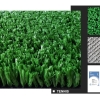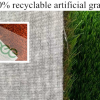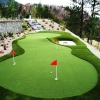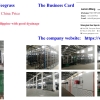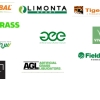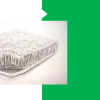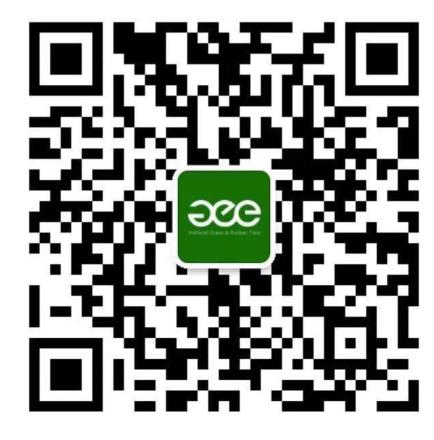Choosing the right artificial grass factory in China matters:
Below is a practical, buyer-focused guide that covers
the brand effect, how manufacturers are distributed across China,
and step-by-step selection criteria and tactics you can use to pick the best partner for your needs.
1.Stable quality systems.
Established brands usually have better R&D, stricter QC, documented production processes, and established raw-material supply chains (yarn, backing, infill).
2.After-sales support and warranty.
Big brands are more likely to offer reliable warranties, technical guidance, and replacement policies — important when selling to demanding markets.
3.Export experience & certifications.
Recognized brands often hold ISO, SGS, CE, or other product-compliance certificates, and understand documentation for customs and overseas standards.
4.Pricing stability.
Brands can command smoother pricing (less volatile) because they source at scale and have long-term contracts with yarn and chemical suppliers.
While major brands offer advantages in the artificial turf industry, they also have some significant disadvantages.
1. Higher prices are common among major brands,
as brand premiums, management costs, publicity investments, and strict quality systems are all reflected in the final quote.
2. Major brands typically have fixed production plans and processes, which can be inflexible.
This leads to slow response times and long lead times for small batches or custom orders.
3. Major brands often have high barriers to entry for cooperation, such as large minimum order quantities (MOQs),
making them unsuitable for small and medium-sized buyers or initial market testing.
4. Brand companies have stricter contracts and after-sales processes, resulting in less room for negotiation and greater difficulty in making changes.
This can limit flexibility for clients who require flexibility, quick response, and cost con.
So brand does not automatically guarantee the best fit.
Some smaller specialist factories produce niche, higher-value turf (e.g., high-performance sports turf, pet turf, or luxury putting greens)
with more customization and lower MOQ. So treat “brand” as one important signal, not the only decision criterion.
2. Where are the manufacturers located — China’s regional distribution
the brand effect, how manufacturers are distributed across China,
and step-by-step selection criteria and tactics you can use to pick the best partner for your needs.
1.The brand effect — why brand names in artificial grass matter
A strong brand among Chinese artificial grass manufacturers signals a range of advantages:1.Stable quality systems.
Established brands usually have better R&D, stricter QC, documented production processes, and established raw-material supply chains (yarn, backing, infill).
2.After-sales support and warranty.
Big brands are more likely to offer reliable warranties, technical guidance, and replacement policies — important when selling to demanding markets.
3.Export experience & certifications.
Recognized brands often hold ISO, SGS, CE, or other product-compliance certificates, and understand documentation for customs and overseas standards.
4.Pricing stability.
Brands can command smoother pricing (less volatile) because they source at scale and have long-term contracts with yarn and chemical suppliers.
While major brands offer advantages in the artificial turf industry, they also have some significant disadvantages.
1. Higher prices are common among major brands,
as brand premiums, management costs, publicity investments, and strict quality systems are all reflected in the final quote.
2. Major brands typically have fixed production plans and processes, which can be inflexible.
This leads to slow response times and long lead times for small batches or custom orders.
3. Major brands often have high barriers to entry for cooperation, such as large minimum order quantities (MOQs),
making them unsuitable for small and medium-sized buyers or initial market testing.
4. Brand companies have stricter contracts and after-sales processes, resulting in less room for negotiation and greater difficulty in making changes.
This can limit flexibility for clients who require flexibility, quick response, and cost con.
So brand does not automatically guarantee the best fit.
Some smaller specialist factories produce niche, higher-value turf (e.g., high-performance sports turf, pet turf, or luxury putting greens)
with more customization and lower MOQ. So treat “brand” as one important signal, not the only decision criterion.
2. Where are the manufacturers located — China’s regional distribution
Artificial grass manufacturing in China is geographically clustered around several industrial regions,
which matters for logistics, lead times, and supplier diversity:
1. Guangdong (Guangzhou, Shenzhen, Dongguan, Foshan): The largest concentration. Advantages: abundant OEM/ODM suppliers, fast export logistics via Shenzhen and Guangzhou ports, and many trading companies. Good for competitive pricing and quick sampling.
2. Zhejiang (Ningbo, Shaoxing, Taizhou): Strong in polymer processing and synthetic-fiber industries. Factories here often have advanced tufting and backing capabilities and convenient sea export via Ningbo.
3. Jiangsu (Yangzhou, Nantong): Good mix of mid-sized manufacturers producing various pile heights and sports turf. Logistics to Shanghai/Nantong ports is convenient.
4. Shandong (Qingdao, Linyi): Hosts some larger-volume producers and industrial textile clusters. Often competitive for volume orders.
5. Hebei / Tianjin region: Close to northern raw-material suppliers; some factories here focus on lower-cost products for domestic markets and nearby exports.
3. Types of factories
1.Large branded factories: Full production lines, in-house yarn extrusion, tufting, backing, R&D labs, export experience.
2.Medium OEM suppliers: Good for private-label orders; may subcontract yarn but control tufting and finishing.
3.Small workshops: Low MOQ and flexible on samples/custom colors but inconsistent QC and weaker documentation.
2. Yarn type (PE, PP, PA), denier, shape (C-shaped, S-shaped), functional additives (UV stabilizer).
3. Stitch rate, pile height, face weight, density and backing layers.
4. Infill recommendations and compatibility with sand/rubber/backing systems.
5. Certifications & test reports
ISO 9001 (quality management), SGS/Intertek lab reports, CE (if applicable), lead & phthalates tests for child/pet safety.
UV resistance / color fastness reports and flame-retardant certificates if required by your market.
6. Production capacity & lead time
Daily/weekly production, ability to scale, and typical lead times for samples and bulk orders.
Peak-season capacity and contingency for raw-material shortages.
7. Customization & R&D
Can they make custom colors, pile structures, logo embossing, or sports-spec turf?
Does the factory provide technical support for installation and maintenance?
8.MOQ & pricing
Understand true unit price at realistic order sizes; very low MOQ often means higher unit cost.
Ask for price breakdowns (yarn, backing, finishing) to pinpoint negotiation room.
9. Quality control & inspection
Factory QC steps: incoming raw material checks, in-line inspections, final roll testing and packaging checks.
Will they allow third-party inspection (SGS/Intertek) before shipment?
Choosing a China artificial grass factory is a mix of objective technical checks (materials, stitch rate, test reports) and practical supplier vetting (capacity, export experience, QC). Use the regional distribution to your advantage when planning visits and logistics, rely on credible test reports and third-party inspections, and always run a small trial order before scaling up. If you’d like, I can now draft a one-page supplier-evaluation checklist you can print and take to factory visits.
2. Zhejiang (Ningbo, Shaoxing, Taizhou): Strong in polymer processing and synthetic-fiber industries. Factories here often have advanced tufting and backing capabilities and convenient sea export via Ningbo.
3. Jiangsu (Yangzhou, Nantong): Good mix of mid-sized manufacturers producing various pile heights and sports turf. Logistics to Shanghai/Nantong ports is convenient.
4. Shandong (Qingdao, Linyi): Hosts some larger-volume producers and industrial textile clusters. Often competitive for volume orders.
5. Hebei / Tianjin region: Close to northern raw-material suppliers; some factories here focus on lower-cost products for domestic markets and nearby exports.
3. Types of factories
1.Large branded factories: Full production lines, in-house yarn extrusion, tufting, backing, R&D labs, export experience.
2.Medium OEM suppliers: Good for private-label orders; may subcontract yarn but control tufting and finishing.
3.Small workshops: Low MOQ and flexible on samples/custom colors but inconsistent QC and weaker documentation.
4.About the practical selection of Chinese artificial turf standards - what needs to be checked
1. raw material:New or second hand2. Yarn type (PE, PP, PA), denier, shape (C-shaped, S-shaped), functional additives (UV stabilizer).
3. Stitch rate, pile height, face weight, density and backing layers.
4. Infill recommendations and compatibility with sand/rubber/backing systems.
5. Certifications & test reports
ISO 9001 (quality management), SGS/Intertek lab reports, CE (if applicable), lead & phthalates tests for child/pet safety.
UV resistance / color fastness reports and flame-retardant certificates if required by your market.
6. Production capacity & lead time
Daily/weekly production, ability to scale, and typical lead times for samples and bulk orders.
Peak-season capacity and contingency for raw-material shortages.
7. Customization & R&D
Can they make custom colors, pile structures, logo embossing, or sports-spec turf?
Does the factory provide technical support for installation and maintenance?
8.MOQ & pricing
Understand true unit price at realistic order sizes; very low MOQ often means higher unit cost.
Ask for price breakdowns (yarn, backing, finishing) to pinpoint negotiation room.
9. Quality control & inspection
Factory QC steps: incoming raw material checks, in-line inspections, final roll testing and packaging checks.
Will they allow third-party inspection (SGS/Intertek) before shipment?
Choosing a China artificial grass factory is a mix of objective technical checks (materials, stitch rate, test reports) and practical supplier vetting (capacity, export experience, QC). Use the regional distribution to your advantage when planning visits and logistics, rely on credible test reports and third-party inspections, and always run a small trial order before scaling up. If you’d like, I can now draft a one-page supplier-evaluation checklist you can print and take to factory visits.

